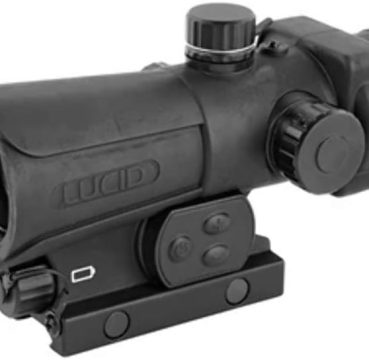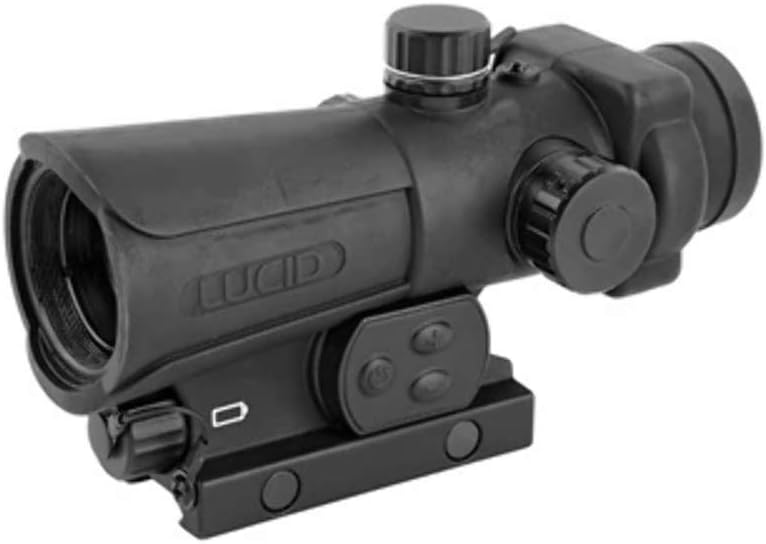For a very long time the optics industry basically produced two kinds of optics. The poorly made and the close to unaffordable. Without a doubt you could get an ‘affordable’ scope, but how long would it last under pressure?
You could also get a quality scope…but be prepared to pay for it. There wasn’t a good middle ground for those looking for a decent scope, at a good price. It wasn’t until the last 5 or so years we’ve really seen quality optics at a good price make an appearance.
Lucid HD 7 GenIII Red Dot
The Lucid HD7 was one of the first scopes to hit the market at a price most could afford and offered an excellent degree of quality. Priced with an MSRP of 199 dollars the Lucid HD7 occupied an interesting space when it was first unveiled.
Now that we are well into the third generation of Lucid HD7 and the price hasn’t changed, and neither has the unwavering commitment to quality. The Lucid HD 7 has been beaten, abused, kicked, and killed as it grew from Gen 1 to 2, and now 3.
It’s only gotten better. Lucid seems dedicated to making sure the HD 7 is a tool you can depend on with your life. To test the first Gen, they tossed them out of planes with paratroopers, and only 1 failed. They still saw that failure and made improvements.
I didn’t jump out of a plane with it, but I did take the Lucid HD 7 for a spin.
Table Of Contents
Lucid HD 7 Optic Specs
Before we dive into performance lets talk a bit about what the Lucid is. The Lucid HD 7 is a red dot optic that lacks any magnification this optic is made for shots at arnage from the end of the barrel to about 200 yards. You can get further with a magnifier, and some skill.
The HD 7 has 4 different reticles. I enjoy each of them and find each useful in their own way. However, in my testing I tend to prefer reticle Number 1. The reticles included are the following:
- Small dot inside large circle
- Chevron Reticle with T shaped drop compensator
- Cross hair with mil dot drop compensation
- Single Red Dot
I’ll go into why I prefer the Number 1 reticle a bit more later.
Let’s take a peek at the numbers and you’ll get a better idea of the HD 7’s overall size.
Length – 5.5 inches
Weight – 13 ounces
Cowtiness? – Yes, Lower 1/3rd
Objective Lens – 34 mm
The Lucid HD 7 GenIII Red Dot – Pre Shoot Setup
Before we dive into shooting with Lucid HD 7 let’s talk a bit about first impressions. Once we get to the range we get a bit more concerned with putting lead downrange than we do things like optical clarity.
The HD 7 runs on a single AAA battery and the system has 7 different brightness levels. These range from a whisper of red light, to oh that kind of burns the eye. The Lucid has an impressive auto brightness sensor that I loved toying with.
It gave me a grin to look through the optic and turn a light on and off. The reticle adjusted quickly and purposefully. Even taking it from room to room at different light levels impressed me.
The reticle decreased and more importantly increased in brightness almost instantly. Manual adjustments could still be made and set if you prefer to rock one setting and no more. I was surprised and impressed with the auto brightness sensor that I just let it do its thing.
Mounting to an optic is easy since the Lucid comes with a single piece built in picatinny rail mount. It’s simple, and effective. It mounts with ease and has remained secure.
Optical clarity wise for a 250ish dollar optic I was pleasantly surprised when I looked through the optic. The image is crisp and clear, even around the edges there is no noticeable distortion. The large 34mm objective lens is certainly being put to use.
The controls for turning the optic on and adjusting the brightness levels are on the left side so right handed shooters can make adjustments without releasing their firing hand. Lefties may not be a big fan, but it worked for me. Reaching the adjustments was simple and easy.
There is also a two hour auto off feature. Which is great because I leave my optics on all the time. I blame on using ACOGs for so long you just kinda forget about batteries. The auto shut off according to the manual is two hours of no activity.
The auto adjusting must count as two hours because I certainly used it on the range for more than two hours without it shutting off. Funny story is I don’t often read the depths of manuals, being a professional gun writer and all I think I know everything.
I just left it on, and the next morning it was off. So, I investigated and sure enough the auto off feature works.
Testing the Lucid HD 7 GenIII Red Dot at 7, 15, and 25 yards
Finally, we make it to the range. Step one was a quick 25 yard zero. Something simple and easy to do with the Lucid. It ½ MOA adjustments will move you left, right, up, and down quickly. I simply fired three round groups, measured my MOA 100 yard target and made adjustments as necessary.
Once I was zeroed I cycled through the different reticles and experimented. For a nonmagnified optic the circle and dot, or just the dot make the most sense. Lucid makes a 5x magnifier, but I didn’t have one. With 1x I’m not at a range where I’m worrying about ballistic drop.
That discounted two reticles for me. At these close ranges the circle and dot seemed to make a lot of sense to me. Close range gunfighting is all about speed and accuracy. You want to get your gun on target, and you want to put holes in that target as rapidly as possible.
The circle and dot gives me a bigger reticle overall, the large circle is easier to pick up with my eye, and quicker as well. This gives it an advantage over just the dot.
At these close ranges I just used that big circle. My theory was simply, fill the circle with my target and start pulling the trigger. It worked, and it worked really well, especially for bad breath distances.
That big circle catches my eye and I can put rounds on target quick, fast, and in a hurry.
Another careful consideration is going to be transition speeds. Transitioning between targets is one of the primary advantages of a red dot over iron sights. It’s simply faster.
The fatal flaw with red dots is blur. Blur is going to occur no matter what, but if the optic’s glass is clear the recovery will be much quicker. With blurriness around the edges the blur will be harder to recover from.
I mentioned earlier the glass was crystal clear so my problems with blur weren’t problems at all. I could transition between multiple targets with ease and put round after round at each target. Even complicated drills like the failure to stop on two targets wasn’t an issue.
That drill has to switching targets 4 times total, so it really stresses proper transitions.
Finding the small target known as the head is easy and rapid. Again, at even 25 yards the head of my targets fit perfectly into my big circle. Put head in circle, pull trigger end the fight.
Backing Off to 100 Yards
Once I hit the hundred yard line I reconfirmed my hasty zero and was satisfied with the results. From here I got off paper targets because I didn’t want to check group sizes and confirm hits visually. Instead I moved to some steel gongs.
Audible confirmation is so much more satisfying. Taking up a solid prone position I made the gong, and ring it dead. Nearly as fast as I could pull the trigger I could keep it singing. 100 yards isn’t much of a challenge in the prone.
I moved to standing, kneeling, and worked some barricades. I used the same circle, but now I’m aiming with the lit dot inside the big circle. Being precise with the Lucid was easy and even if the standing and kneeling positions I had little trouble making the gongs sing.
Overall the Lucid HD 7 impressed the hell out of me. In close quarters, and more extended ranges I had zero issues hitting my targets. I found the optic easy to use and even after hours at the range I can’t find much to complain about.
I’d easily trust the Lucid HD 7 as a home defense optic, especially after seeing its close-range performance. It’s crystal clear optics make it perfect for ranges out to 200 yards, and the addition of a magnifier can pull you out either further. The Lucid isn’t the fanciest scope, but it excels at the basics of riflery, and we can’t ask for much more than that at its price range.












